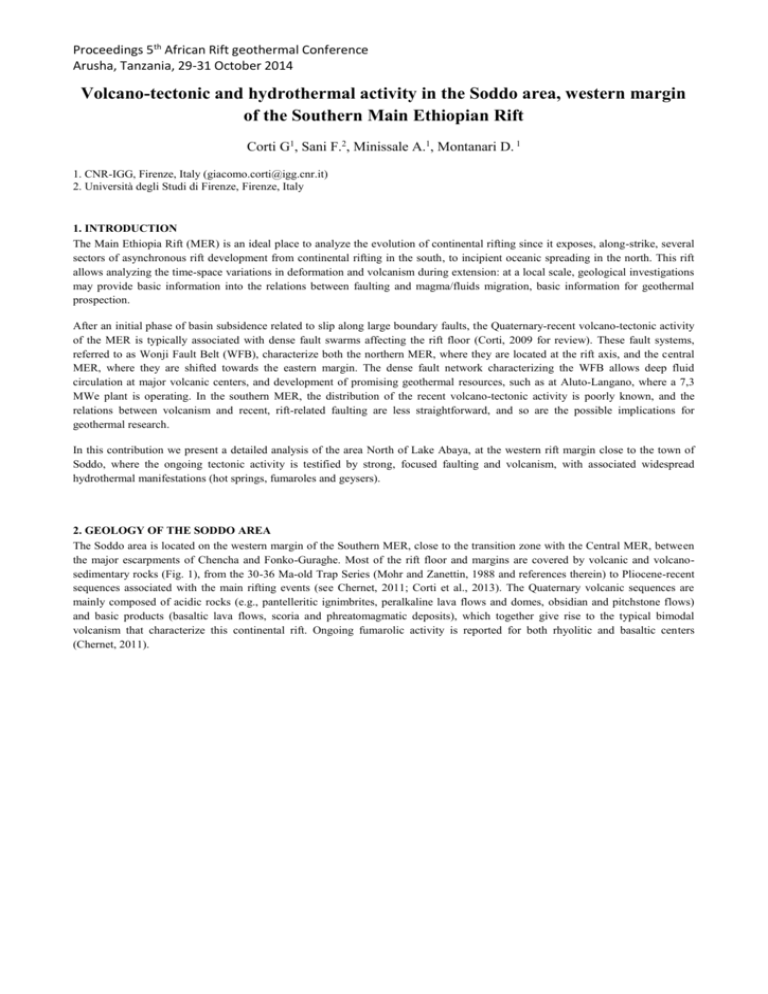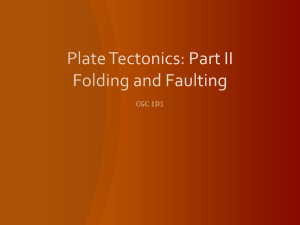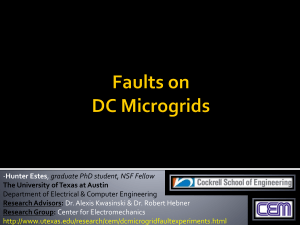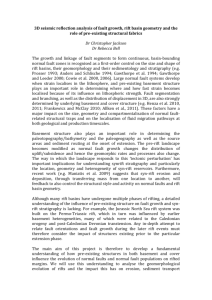Volcano-tectonic and hydrothermal activity in the Soddo area
advertisement

Proceedings 5th African Rift geothermal Conference Arusha, Tanzania, 29-31 October 2014 Volcano-tectonic and hydrothermal activity in the Soddo area, western margin of the Southern Main Ethiopian Rift Corti G1, Sani F.2, Minissale A.1, Montanari D. 1 1. CNR-IGG, Firenze, Italy (giacomo.corti@igg.cnr.it) 2. Università degli Studi di Firenze, Firenze, Italy 1. INTRODUCTION The Main Ethiopia Rift (MER) is an ideal place to analyze the evolution of continental rifting since it exposes, along-strike, several sectors of asynchronous rift development from continental rifting in the south, to incipient oceanic spreading in the north. This rift allows analyzing the time-space variations in deformation and volcanism during extension: at a local scale, geological investigations may provide basic information into the relations between faulting and magma/fluids migration, basic information for geothermal prospection. After an initial phase of basin subsidence related to slip along large boundary faults, the Quaternary-recent volcano-tectonic activity of the MER is typically associated with dense fault swarms affecting the rift floor (Corti, 2009 for review). These fault systems, referred to as Wonji Fault Belt (WFB), characterize both the northern MER, where they are located at the rift axis, and the central MER, where they are shifted towards the eastern margin. The dense fault network characterizing the WFB allows deep fluid circulation at major volcanic centers, and development of promising geothermal resources, such as at Aluto-Langano, where a 7,3 MWe plant is operating. In the southern MER, the distribution of the recent volcano-tectonic activity is poorly known, and the relations between volcanism and recent, rift-related faulting are less straightforward, and so are the possible implications for geothermal research. In this contribution we present a detailed analysis of the area North of Lake Abaya, at the western rift margin close to the town of Soddo, where the ongoing tectonic activity is testified by strong, focused faulting and volcanism, with associated widespread hydrothermal manifestations (hot springs, fumaroles and geysers). 2. GEOLOGY OF THE SODDO AREA The Soddo area is located on the western margin of the Southern MER, close to the transition zone with the Central MER, between the major escarpments of Chencha and Fonko-Guraghe. Most of the rift floor and margins are covered by volcanic and volcanosedimentary rocks (Fig. 1), from the 30-36 Ma-old Trap Series (Mohr and Zanettin, 1988 and references therein) to Pliocene-recent sequences associated with the main rifting events (see Chernet, 2011; Corti et al., 2013). The Quaternary volcanic sequences are mainly composed of acidic rocks (e.g., pantelleritic ignimbrites, peralkaline lava flows and domes, obsidian and pitchstone flows) and basic products (basaltic lava flows, scoria and phreatomagmatic deposits), which together give rise to the typical bimodal volcanism that characterize this continental rift. Ongoing fumarolic activity is reported for both rhyolitic and basaltic centers (Chernet, 2011). Corti et al. Figure 1. Left. Geological map of the Soddo area (modified from Ethiopian Mapping Agency, 1981; Chernet, 2011). Right. Structural map of the Soddo area with sites of structural measurements and directions of extension obtained through fault-slip data inversion. Top-right plot displays the cumulative analysis of fault-slip data (Wulff net, lower hemisphere) collected in the Soddo area. Indicated is the location of the three cross-sections (A, B, C). Corti et al. Figure 2. Geological cross-sections through the study area (location in Fig. 1). Stereographic projections (Wulff net, lower hemisphere) display the fault planes and the collected associated fault-slip vectors; black arrows indicate the obtained direction of extension. Radiometric dating of faulted material is also reported. 3. QUATERNARY VOLCANO-TECTONIC ACTIVITY IN THE SODDO AREA Pervasive deformation affects the western rift margin southeast of Soddo, giving rise to a complex system of roughly N20°E to N25°E-trending border faults; more limited faulting affects the rift floor northeast of Lake Abaya, with a set of N5°E to N10°Etrending internal (Wonji) faults (Figs. 1-3). The border fault system is characterized by numerous closely spaced faults, resulting in the highest fault density of the whole Southern MER. This fault system is made of a typical array of sigmoidal, right-stepping enechelon normal or oblique faults, with limited lateral extent (maximum length in the range of a few kilometers) and limited vertical offset (typically in the range of a few tens of meters, and up to 150-200 m). This sigmoidal, en-echelon arrangement of faults likely reflects a sinistral component of motion along the western rift margin (Corti et al., 2013). Typically, the faults have well-developed fault zones, with thick fault breccia along the fault plane. 14C dating of organic matter involved in faulting giving minimal ages of fault activity spanning from the latest Pleistocene to the Holocene (see Fig. 1), with slip rates ranging between ~1 and ~9 millimeters per year (Corti et al., 2013). Inversion of kinematic indicators on the fault results in a roughly E-W to ESE-WNW direction of extension (Fig. 1). There is a close correlation between the recent volcanic activity and faulting in the Soddo area. The geological map in Fig. 1 clearly displays a close association between outcrop of the widespread Quaternary basalts and the numerous faults affecting the rift margin. Corti et al. Figure 3. A) Panoramic view of the normal fault at site 17; b) detail of the fault zone; c) paleostress analysis of the fault-slip data collected on the fault plane, indicating a N110°E-directed extension A detailed analysis of the distribution and characteristics of the recent volcanic centers (domes, scoria cones, fissure ridges, etc.) in relation to major and minor faults supports the strong link between the two processes as also suggested by previous works (e.g., Boccaletti et al., 1998) (Figs. 4, 5). In particular, most of the eruptive vents are located along the recent sigmoidal, en-echelon faults that characterize the area. Basaltic spatter cones represent the majority of these centers, although clear relations between faults and volcanoes are also observed for the rhyolitic centers whose eruption vents are located along major, roughly NE-SW normal faults (Fig. 4). Cones may be located at fault tips, in the centre of fault segments or within zones of interactions between faults (such as relay zones; Fig. 5); a more limited number of small cones are not apparently strictly related to single faults. In order to better characterize the distribution of vents in the area, and to better define their relations with faults, we have mapped vent alignments, and assessed their reliability, according to the procedure illustrated in Paulsen and Wilson (2010). Vent mapping has been performed on available satellite images, DEMs and aerial photos; mapping has been performed based on the spatial distribution of vents as well as their shapes (vent elongation provides a critical parameter to group single vents into an alignment). The distribution of both vent alignments and elongate vent long axis shows a main peak at N20°-25°E, indicating a striking correspondence with the trend of the border faults in the area, and thus strengthening the close relations between faulting and volcanism. Since volcanic alignments provide an indirect means to assess the trend of subsurface dikes (e.g., Paulsen and Wilson, 2010 and references therein), the above observations indicates a strong link between boundary faults and the feeder dike system and suggests extension to be accommodated by a combination of faulting and magma intrusion (e.g., Rooney et al., 2011). To complete the analysis, we have also calculated the azimuthal distribution of cone breaching, whose trend tends to parallelize vent alignments (as well as the trend of border faults), with a minor peak orthogonal to this latter trend. Both observations are in agreement with theoretical predictions (Tibaldi, 1995). Corti et al. Figure 4. Relations between eruption vents and faulting illustrated as (a) satellite image and (b) structural interpretation of the area close to the Salewa Dore and Hako centers. Inset shows the main vent alignments (brownish shading), defined on the basis of both the visual analysis of the spatial distribution of vents and the analysis of their elongation. c) Schematic representation of attributes used to characterize and assess vent shape and vent alignments (after Paulsen and Wilson, 2010). The best-fit line for an alignment is calculated by minimizing the orthogonal distances from points to the line. The angular deviation of elongate vents from the best-fit line is measured as the acute angle separating the long axis of the elongate vent and the best-fit line. Vent spacing distance is defined as the distance that separates adjacent vents found along the trace of the best-fit line. The axial ratio for single cones is calculated as the ratio between the lengths of the long and short axes of the best-fit ellipse matching the mapped shape of the vent (vents are considered elongate when the axial ratio is >1.2; Paulsen and Wilson, 2010). d) Azimuthal distribution of vent alignment and elongate vent long axis; e) azimuthal distribution of cone breaching (calculated by considering the long axis of the breached area). Corti et al. Figure 5. 3D view of satellite imagery (Google Earth image; top panel) and structural interpretation (central panel) illustrating the typical location of basaltic spatter cones with respect to major normal faults. Bottom panel: photo showing a basaltic spatter cone cut by a normal fault (base of the fault scarp indicated by the white arrows) 4. RELATIONS WITH THE HYDROTHERMAL ACTIVITY The area is marked by widespread hydrothermal manifestations such as hot springs (Fig. 6), boiling fumaroles, boiling pools and geysers, which have been generally related to the presence of advective hydrothermal systems around the main volcanoes of the area (Ayale et al., 2002). These manifestations are strongly focused along major normal faults, suggesting also that the fault pattern has major control on the volcanic and hydrothermal systems, or at least for the rising of deep-seated fluids (Chernet, 2011). The thermal springs and/or group of springs are located and/or named: Wache (max T=96 °C; pH 9.6), Chawokare (max T=66 °C; pH 6.8), Bolocho (max T=89 °C; pH 8.2), Bilate (max T=68 °C; pH 7.4), Tobacco Plantation (max T=73 °C; pH 8.0), Donga (T ranging 48-51 °C; no pH), Dimtu (T=40 °C; pH 7), Hamesa (T=37 °C pH 6.4). Steam vents (or steaming ground) are present at: Bilbo (T=95 °C), Saleva Dore (T=90 °C), Hako (T=43 °C). All the emergences are schematically shown in Figure 6 (after Chernet, 2011). Corti et al. Fig. 6 – Thermal springs and steam vents areas located north of the Abaya lake. The thermal springs have been the object of geothermal prospection since 1972, when a UN mission took most of them and analyzed for main chemistry and some trace elements (UNDP, 1973). A second mission leaded by Harmon Craig (Craig et al., 1977) took again most of the 1972 samples, again for main and trace elements, as well as for several isotopic compositions, among which: the 18O and D in thermal springs, rivers, and rain, total helium and 3He/4He ratio, and 13C/12C measurements in free CO2 and dissolved carbon of some springs. A third sampling campaign again on the thermal springs was carried out in 2000 (Beyene, 2006). No data, apart from the temperature, exist on the fumaroles, and no data exist for the Donga thermal springs area in the eastern sector of the Abaya lake. The 2000 data set has been discussed, in comparison with the previous 1972 and 1977 data, by Ayale et al. (2002), Beyene (2006), Teclu (200?) and Chernet (2010), generally suggesting that the area is interesting from a geothermal prospection point of view. At this stage, by considering that there are no data on the gas phases associated with the springs and that the high pH (9.6) measured in the most vigorous emergence at Wake (a stable 95 °C spring) is hard to relate with the nearby Chawokare springs where the pH is much smaller, it is not possible to say if active hydrothermal systems are present in the area and if they discharge fluids to the surface. In general, the presence of steam at surface, even if coming from a secondary boiling, is a very good indication of high thermal gradients in the area. To the same good perspective is the presence of many thermal springs (apart from Wake) with the ordinary Na-HCO3 composition of cold groundwater, with relative low-salinity (about 1000 mg/kg), such as those of Bilate, Tobacco plantation and Bolocho. Since they are hot, it means that the thermal flow is very high. Nevertheless, the pH, especially considering that in the 1977 campaign was measured in the field and therefore should be good values, seems to be too high for the presence of rising hydrothermal CO2-rich fluids. But CO2 seems to bubble from the Chawokare springs (Fig. 7) and in fact pH of 6.6 has been reported. To the same indication of good geothermal potential is the high 3He/4He ratios measured by Craig (1977) at several localities (as Rsample/Rair: 8.3 at Tobacco plantation, 7.3 at Chawokare) clearly pointing to mantle gas degassing (Craig et al., 1978). It is interesting to note that the best, and most promising thermal spring in the area at Wache, has the lowest 3He/4He ratio (3.3). This low ratio is Corti et al. somehow in line with the high pH there measured, and may suggest that this very hot and saline spring is actually the less representative of any eventual active system in the area, being related to a convective regional fluid circulation located to the boundary of more northernmost active hydrothermal systems. According to what reported, a new sampling campaign on the gas phases and the fumaroles seems to be necessary to have a panorama of the potentiality of the area in terms of geothermal potentiality. Figure 7. Hot springs north of Lake Abaya REFERENCES Ayale A., Teklemariam M. and Kebede S. (2002) Resources exploration in the Abaya and Tulu Moye-Gademsa geothermal prospects, main Rthiopian rift. Compiled Report Geological Survey of Ethipia, 69pp Beyene K. (2006) Geochemical study of the Abaya geothermal prospect. Presented at ARGeo-C1 Congress, 24 Nov.-2 Dec., Addis Ababa, Ethiopia Boccaletti, M., Bonini, M., Mazzuoli, R., Abebe, B., Piccardi, L., Tortorici, L. 1998. Quaternary oblique extensional tectonics in the Ethiopian Rift (Horn of Africa). Tectonophysics, 287, 97-116. Chernet, T., 2011. Geology and hydrothermal resources in the northern Lake Abaya area (Ethiopia). Journal of African Earth Sciences, 61, 129-141 Corti, G., 2009. Continental rift evolution: from rift initiation to incipient break-up in the Main Ethiopian Rift, East Africa. Earth-Sci. Rev., 96, 1–53. Corti et al. Corti G., Sani F., Philippon M., Sokoutis D., Willingshofer E., Molin P. (2013). Quaternary volcano-tectonic activity in the Soddo region, western margin of the Southern Main Ethiopian Rift. Tectonics, 32, 861–879. Craig H., Craig V., Horowits M. and Lupton J.E. (1977) Isotopic geochemistry and hydrology of geothermal waters in the Ethipian Rift Valley. Isotope Lab., Scripps Institution of Oceanography, Univ. of California at San Diego, 140pp Craig H., Lupton J.E. and Horibe Y. (1978) A mantle helium component in Circum-Pacific volcanic gases: Hakone, the Marianas and Mt Lassen. In: E.G. Alexander jr. and M. Ozima (eds.), Terrestrial Rare Gases, Advances in Earth & Planet. Sci. 3, 3-16 Paulsen, T.S., Wilson, T.J., 2010. New criteria for systematic mapping and reliability assessment of monogenetic volcanic vent alignments and elongate volcanic vents for crustal stress analyses. Tectonophysics, 482, 16–28. Rooney, T.O., Bastow, I.D., Keir, D., 2011. Insights into extensional processes during magma assisted rifting: Evidence from aligned scoria cones and maars. Journal of Volcanology and Geothermal Research, 201, 83–96. Teclu A. (200?) Geochemical and isotopic study of the North Lake Abaya geothermal prospect. Argeo files (http://theargeo.org/home/files/Ethiopia/), 5pp Tibaldi, A., 1995. Morphology of pyroclastic cones and tectonics. Journal of Geophysical Research 100, 24521–24535. U.N.D.P.-Unit. Nations Develop. Progr. (1973) Investigation of geothermal resources of power development: geology, geochemistry and hydrogeology of hot springs of the East Africa Rift System within Ethiopia. DP/SF/UN 116 Technical Report, United Nations, New York, 275pp






